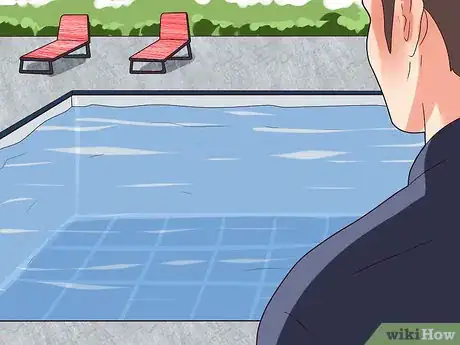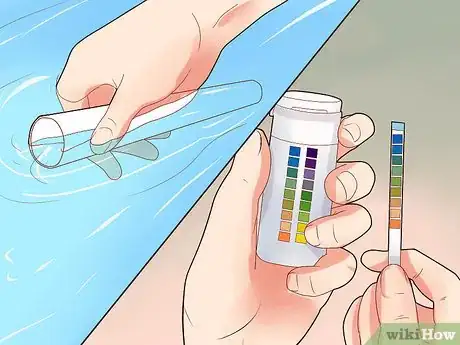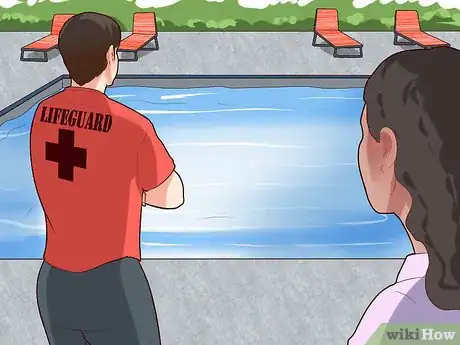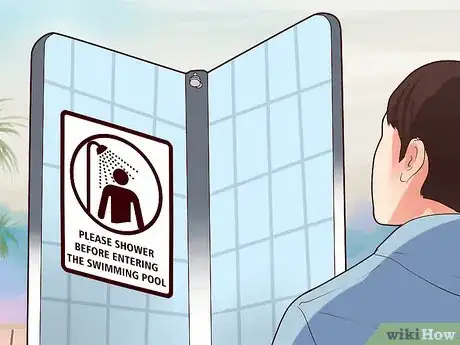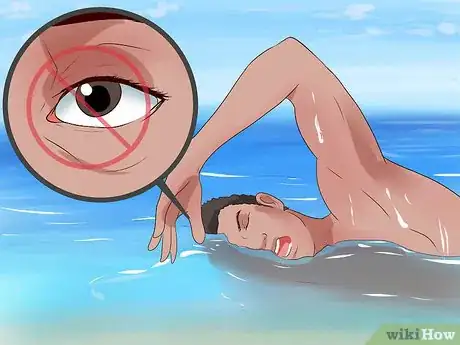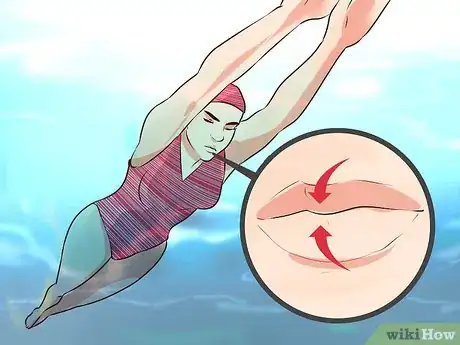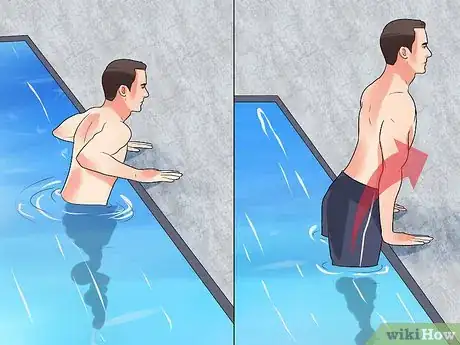X
This article was medically reviewed by Jennifer Boidy, RN. Jennifer Boidy is a Registered Nurse in Maryland. She received her Associate of Science in Nursing from Carroll Community College in 2012.
This article has been viewed 14,613 times.
During the late spring and early summer, there is nothing better than cooling off in a pool. If you don't have one of your own, you may consider taking you and your family down to the public pool. However, public pools may not always be safe from water born diseases. If you are using a public pool, there are ways to know if your public pool is safe.
Steps
Method 1
Method 1 of 3:
Checking Safety Before You Swim
-
1Look for pool inspection results. Public pools must go through a public inspection to ensure its cleanliness and to ensure that there are no rampant health hazards. When you are choosing a public pool, look for the results posted around the pool. If they are not listed, ask the people that work at the pool when the last pool inspection was and where the information is posted.[1]
- The Centers for Disease Control have a database of state regulations in regards to public pools if you want more information about your local pool inspection specifications.
-
2Check water clarity. Before you swim or allow your family to swim in a public pool, you need to look at the clarity of the water. The water should be clear and blue. Look for any cloudiness in the water. Make sure you can see all the way to the bottom of the pool, even the deep end.
- If the water is tinted green or it is cloudy, it may be contaminated with algae.
- Also check the drains to ensure that there is no debris around the drain and that the cover is securely fastened and not cracked.[2]
- Glance around the pool. Make sure that there are no chemicals left by the poolside or out in the open where children can reach them.
Advertisement -
3Test the pool water. When you go to a public pool, you can test the chemical levels to make sure they are within the recommended range. [3] You can buy pool test strips in general stores, but you can also get free test strips from the Water Quality and Health Council's website.[4] When you check the pool levels, you need to make sure that:
- Chlorine is at least 1 ppm
- Bromine is at least 3 ppm
- The pH levels are between 7.2 and 7.8
-
4Check for heavy chemical smells. If you notice a strong smell of chlorine or other chemicals, the pool may not be as clean as you think it is. The smell often comes from something called chloramines, which develop from a mixture of chlorine, sweat, dead skin cells, and other waste. This water might cause irritation to your eyes and skin.
-
5Find a lifeguard. When you are looking for a safe pool, check to see if a lifeguard is on duty. Having a lifeguard will make sure that you and your family is safe. If there isn't a lifeguard on duty, make sure there is a posted sign that says "No Lifeguard on Duty."
- You can also look for rescue equipment, such as a pole or ring, readily available for use in case someone is drowning or hurt in the pool.
- Also watch the behavior of the lifeguard. Make sure he or she is watching the swimmers and is not distracted by his or her friends, phone, or anything else.[5]
-
6Look for rules involving cleanliness. Most public pools should have showers. In order to make sure people are clean before they go in, see if there are rules posted that require a short shower before entering the pool. This will help wash off any germs that may be on someone's body.
- There should also be rules that forbid people to get in the pool when they are sick or have an open wound.
- Also look for rules that prohibit peeing in a pool, about letting a child wear diapers in a pool, and about changing children far away from the pool to avoid contamination.[6]
Advertisement
Method 2
Method 2 of 3:
Staying Safe As You Swim
-
1Avoid opening your eyes. Germs in pool water can be spread to your eyes, which can cause eye irritations and infections. When you are at the public pool, avoid opening your eyes while you are underwater. Tell your children to also keep their eyes closed when they are under water.
- If you want to be able to see underwater, use goggles at the pool to protect your eyes from the contaminated water.[7]
-
2Keep water out of your mouth. Water born illnesses can be spread by swallowing pool water. When you are at the pool, make sure you avoid swallowing any of the pool water. [8] This is true for putting your fingers in your mouth after you have gotten out of the pool when you are still wet or before you have had a chance to shower off the pool water.
- Make sure you keep your children's hands out of their mouths as well so they do not get sick.
-
3Take pool breaks. Every hour or so, you and your family should take a break from being in the pool. This will give all of you time to go to the restroom, stay hydrated, and rest a little before getting back in.
- You should also reapply sunscreen when you are out, since most sunscreens will get washed away after continued exposure to water.
Advertisement
Method 3
Method 3 of 3:
Looking for Common Waterborne Diseases
-
1Learn about recreational water illnesses (RWI). Even if you protect yourself and your family, someone may still develop one of a series of recreational water illnesses. These illnesses are caused by various germs, including bacteria, viruses, fungi, or other microbes found in pools. They can also be caused by the chemicals used in the pool water.
- Common germs that cause RWI are E. coli, Cryptosporidium, and norovirus
- You come into contact with them through exposure to the water, including swallowing, breathing in the water mist in the air, and other general contact with the infected water.[9]
-
2Recognize the types of RWIs. There are a number of types RWIs that you can develop from swimming in public pools. These include eye, ear, skin, respiratory, gastrointestinal, and wound infections caused by the germs. Common illnesses that are caused by the various waterborne germs are:
- Diarrhea, which is the most common
- Stomach aches
- Bloating
- Cramping
- Skin rashes
- Ear infections
- Upper respiratory infections
- Eye and lung irritation[10]
-
3Know where to be cautious. Swimming pools are only one area where you need to be careful to prevent RWIs. Chlorine and other chemicals used in water do not kill all the germs that are released into the water, so you need to be cautious even if you know a pool or other public water recreation area uses chemicals. The additional water recreation areas include:
Advertisement
References
- ↑ http://www.cdc.gov/healthywater/swimming/swimmers/steps-healthy-swimming.html
- ↑ http://www.cdc.gov/healthywater/swimming/swimmers/steps-healthy-swimming.html
- ↑ http://www.cdc.gov/healthywater/swimming/swimmers/steps-healthy-swimming.html
- ↑ http://www.cdc.gov/healthywater/swimming/swimmers/pool-spa-test-strips.html
- ↑ http://www.cdc.gov/healthywater/swimming/swimmers/steps-healthy-swimming.html
- ↑ http://www.cdc.gov/healthywater/pdf/swimming/resources/share-fun-not-germs-508c.pdf
- ↑ http://www.cdc.gov/healthywater/swimming/swimmers/rwi.html
- ↑ http://www.cdc.gov/healthywater/swimming/swimmers/rwi.html
- ↑ http://www.cdc.gov/healthywater/swimming/swimmers/rwi.html
About This Article
Advertisement

